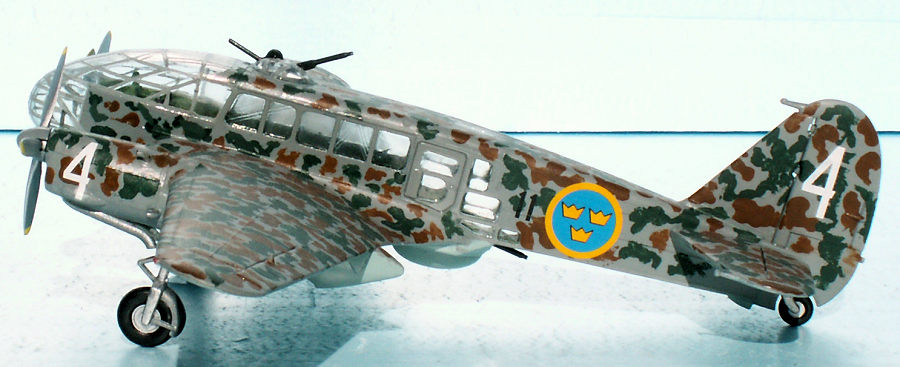
| KIT #: | 106 |
| PRICE: | $20.00 |
| DECALS: | Four options |
| REVIEWER: | Torben Plesberg |
| NOTES: | 1972 release |

| HISTORY |
The Caproni CA 313 was a light twin engine bomber and reconnaissance aircraft designed and built in the late 1930s. The fuselage was a metal construction with an extensively glazed nose without step like the German Heinkel He 111. The wings were of wooden construction, and this showed up to shorten the life time of the airframe considerably, because of rot.
The CA 313 was powered by a
pair of Isotta Fraschini inverted V engines with an output of 750 hp each. The
top speed was 420 km/h, rather fast at that time. The predecessor of the CA 313,
the CA 310 was powered by Piaggio P. VII C.35 radial engines, which had a
considerably higher aerodynamic drag, and thus a slower speed. The bomb load was
800 k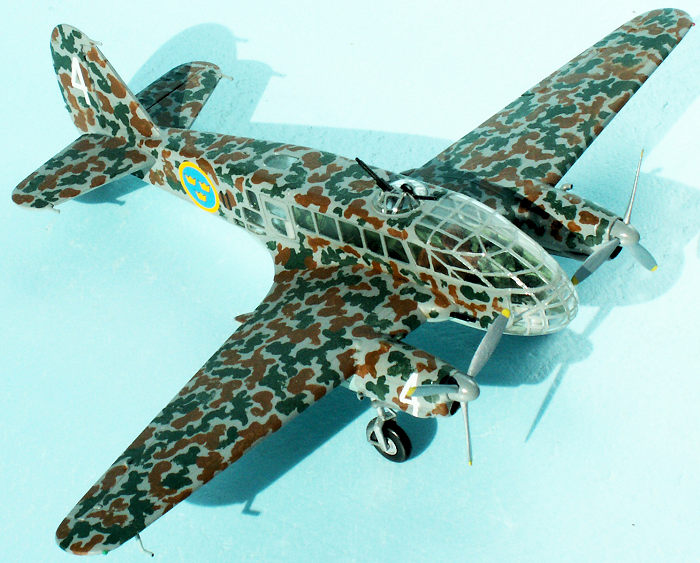 g, and the CA 313 was armed with 2 MGs in the wing roots, a MG in a dorsal
turret, and a rearward firing MG under the belly. Optionally two 20 mm cannons
could be carried under the wing roots.
g, and the CA 313 was armed with 2 MGs in the wing roots, a MG in a dorsal
turret, and a rearward firing MG under the belly. Optionally two 20 mm cannons
could be carried under the wing roots.
The CA 313 served mainly with the Regia Aeronautica, the Italian Air Force in the Mussolini era. A second large operator was the Swedish Air Force, Flygvapnet, with 84 aircraft delivered. France had ordered 200 aircraft, got only 5 because of the war, and Britain had ordered 300 aircraft and got none! Belgium had ordered 24 aircraft, but they were not delivered, as Belgium was overrun by German troops in 1940.
Thirty of the Swedish Capronis were in service as light bombers under the designation B 16 with the F 7 wing. (B for bomber) Forty aircraft served with the F 3 wing as reconnaissance bombers under the designation S 16 A. (S for spaning = reconnaissance.) Fourteen aircraft were planned to be torpedo bombers, T 16 A. However these aircraft were never modified for torpedo carrying, and the aircraft flew as B 16 A bombers.
The aircraft suffered three severe accidents, and the Caproni fleet was grounded for a year. During this period, the aircraft were thoroughly checked by the workshops of the F 11 wing, and the necessary modifications were made to make the Capronis safe to fly. When the modification program was carried out, there were sixty seven S 16 A, and fourteen S 16 B, which were allocated to the F 3 and F 11 wings. The reconnaissance equipment was SKA 4 cameras for vertical photography, and HK 6 hand cameras for all other photography. Later, two S 16 A aircraft were modified for transport of personal and got the designation Tp 16 A. They served with the staffs of the F 3 and F 11 wings.
The Caproni CA 313 was very well suited for the task of reconnaissance in the Baltic area and along the west coast up to Norway. The Caproni was a well flying and fast aircraft. It turned up, that it was not strong enough for the Swedish “störtbombfällningar” (dive bombing), and that is why all aircraft were modified for the less demanding long range reconnaissance role.
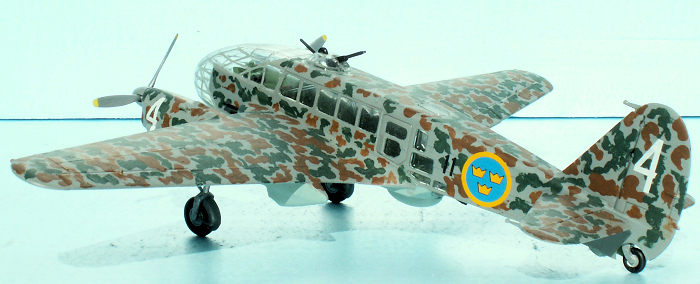 In 1945 the
wooden main spars of the wings were more or less rotten by water coming in
through small leaks arisen over the years. The whole matter ended up with the
second grounding of the Caproni fleet – and the aircraft were used as targets
for shooting exercises, not a single aircraft survived!
In 1945 the
wooden main spars of the wings were more or less rotten by water coming in
through small leaks arisen over the years. The whole matter ended up with the
second grounding of the Caproni fleet – and the aircraft were used as targets
for shooting exercises, not a single aircraft survived!
Nevertheless, the Flygvapen Museum shows a Caproni Ca 313 aircraft. How come? In 1988 the Swedish National Television broadcaster, SVT, made a series telling the fate of a Flygvapen Caproni pilot during WWII. The Swedish television needed a full size mock-up of the Caproni Ca 313, and a large radio controlled scale model for the aerial scenes. The mock-up was built after original drawings, and is therefore a rather authentic model scale 1:1. I have seen the Swedish series, which was shown on Danish TV in the beginning of the nineties. The Scenes with the mock up and the R/C flying model were very convincing. In 1994 I visited the Flygvapen Museum and saw the mock up. It was very realistic, even at close range.
This mock up is the only existing full size Caproni 313 in the world, since no real aircraft survived – in Sweden or elsewhere. The mock up is not the subject of my model. As subject I have chosen an S 16 A from the F 11 - and with the individual number 4. During the early years, there were no national markings on the upper side of the wings. The color scheme is probably right, in the least according to information given by Björn Karlström.
| THE KIT |
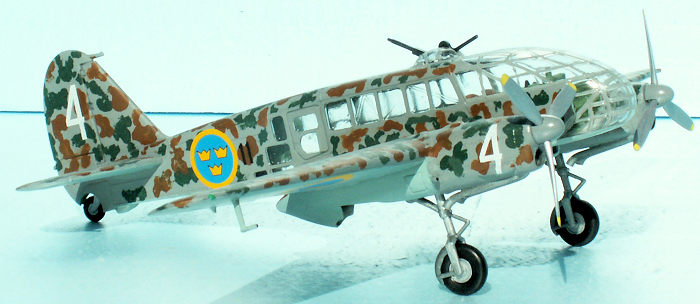 The kit
comes in a fairly large box with a scene from Italy on the lid, showing a
Caproni being serviced by ground crews. The instructions is a single large
folded sheet. On the front there is a short history of the Caproni Ca 313/314 –
only in Italian! On page two the three sprues of the kit are shown with the
parts numbered. Pages three and four show in four steps, how to put the model
together. Pages five and six show the color schemes and decaling of the four
options of the kit. There is no color guide for a specific brand of color. It is
completely up to you to search for further documentation of the colors. The
decal sheet has options for two Italian aircraft with stepped canopy, and a
French and Swedish aircraft without steps. The quality of the decal sheet is
unknown, since I used alternative decals for my model.
The kit
comes in a fairly large box with a scene from Italy on the lid, showing a
Caproni being serviced by ground crews. The instructions is a single large
folded sheet. On the front there is a short history of the Caproni Ca 313/314 –
only in Italian! On page two the three sprues of the kit are shown with the
parts numbered. Pages three and four show in four steps, how to put the model
together. Pages five and six show the color schemes and decaling of the four
options of the kit. There is no color guide for a specific brand of color. It is
completely up to you to search for further documentation of the colors. The
decal sheet has options for two Italian aircraft with stepped canopy, and a
French and Swedish aircraft without steps. The quality of the decal sheet is
unknown, since I used alternative decals for my model.
| CONSTRUCTION |
If you follow the instructions you will not end up with a Swedish Caproni Ca 313. There are some differences between the Italian and the Swedish aircraft.
The interior is simple enough to build, and the parts fit well. A Caproni has a lot of internal structure – steel tubing reinforcing the steel construction of the fuselage. Some of these can be seen on the large window parts 15 & 19. These parts should be painted (interior green) before the assembly of the fuselage. I have nothing to suggest what an Italian light interior green is, however I applied HB 120 light green – hoping it is not entirely wrong. I have recently learned, that the exact color is FS34558.
The
transparent parts fit very well especially the two large ones: 32 & 33. There
are a lot of frames to be painted. Masking was not necessary since the frames
are fine raised double lines. These raised double lines keep the paint in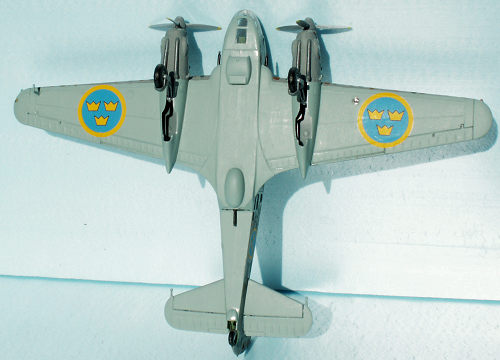 side
the frames, if you are careful, and do not put too much paint on the very thin
brush needed for this job.
side
the frames, if you are careful, and do not put too much paint on the very thin
brush needed for this job.
The tail wheel is placed in a semi-circular recess under the fin. This recess must be cut and sanded in shape. The gauge of the recess should be about 1.5 mm larger than the gauge of the tail wheel. This recess can be made before or after the assembly of the fuselage halves.
The propeller assemblies may be put in place as the very last step of the construction. The same procedure was possible during the construction of the BV 138 flying boat, see here.
Step 4 of the instructions needs a lot of attention, when doing a Swedish Caproni. Parts 74 & 77 – 20 mm guns – should be omitted, they are only for Italian aircraft. Photos suggest that parts 56 & 57 are mostly not applied to Swedish aircraft. Parts 78 & 82 – torpedo – are not applied either.
The engine nacelles need some modifications to be Swedish. The oblong bulges on either side of the nacelles should be shortened considerably, to about half of the length. The Swedes put a pair of long exhaust tubes on the underside of the nacelles, probably a part of the modification program following the first grounding of the Caproni fleet. These exhaust were made of sprues, which curved in the ends. Finally, there are three small circular air intakes on each nacelle. Two of these are placed symmetrically two thirds down the sides of the nacelles as seen from the front, and where the exhausts end as seen from above. The third intake is placed three mm to the right of the “center bulge” on the top of the nacelles. These intakes were made of a 1.5 softened brass wire. The wire was softened by heating it to red hot condition. The softening made it possible to bend the wire 90 degrees to simulate the small intakes.
The extensive glazing of the aircraft made it an easy job to create the S 16 A reconnaissance version from the standard bomber B 16 A/B. However, I had no documentation of the look of the cameras or exactly where they were placed.
| COLORS & MARKINGS |
The most difficult part of the building of a Swedish Caproni is getting the color scheme right – or in the least somewhat trustworthy. The suggested color scheme of the instructions may be trustworthy, however the camouflage pattern is not, compared to the few photos I have seen. In other words: I made my own solution for what I consider being a trustworthy camouflage pattern.
The
undersides are light blue grey, RLM 65. The upper sides are medium sea grey, HB
165. The na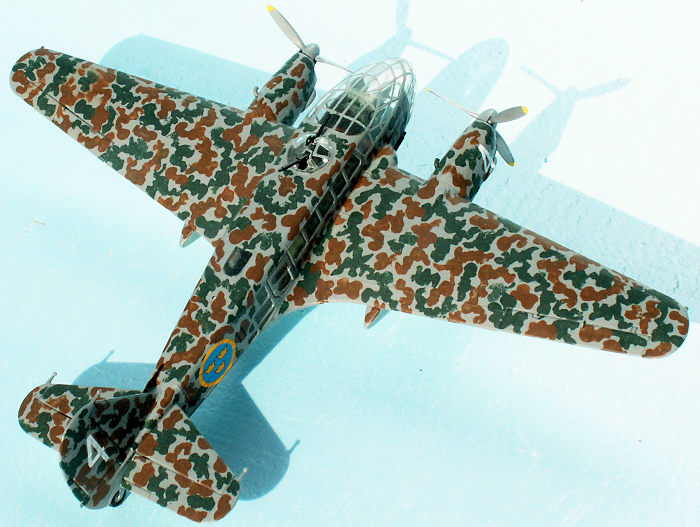 celles in front of the wing has also this this color on the
undersides. The leading edge of the wings has a stripe in this color on the
underside, 2.5 mm at the roots tapering to a little less than one mm at the wing
tips.
celles in front of the wing has also this this color on the
undersides. The leading edge of the wings has a stripe in this color on the
underside, 2.5 mm at the roots tapering to a little less than one mm at the wing
tips.
The camouflage pattern consists of dark green and rust brown blotches. To make these uneven shaped blotches in a trustworthy way, I made seven different dies from fine grained foam. Each die could make a certain blotch when it was dipped into paint. It took a couple of hours to make the blotches in dark green – HB 149 - and rust brown – HB 186. When the blotches had dried until the following day, I made a touch up, partly with the dies and partly with a small brush. It was a real challenge to make the camouflage pattern look like something I had seen on a few not too perfect black white photos.
The blotches on the original aircraft were of course sprayed on. However, I don’t use an airbrush for my models, and I guess the 1/72 small Caproni is too small for spraying the blotches on. Well, I may be wrong, because I am ignorant on using fine airbrushes.
The decaling was not done by applying the decal sheet of the kit. The national insignia were too small and the colors not correct. The four needed crown markings were taken from a Flying Color sheet with Swedish national roundels to 1/72 scale. The white letters were also from a Flying Colors sheet, Swedish numerals white. The black “11” came from a stock sheet with Swedish markings. One might wonder why only four national roundels were needed? Simply because national markings were not applied on the top of the wings during WW II.
After the decaling the whole aircraft got a layer of HB Satin Cote to protect the decals and give the model a nice finish.
| CONCLUSIONS |
The old Italaerei Caproni Ca 313 kit is a classic kit with a few raised panel lines. The parts fit well together and any modeler with a little experience will be able to build a fine model of this rather special light bomber aircraft from WWII. The kit is very recommendable no matter which of the four options you choose to build. It was great fun and a challenge to build the Swedish S 16 A reconnaissance aircraft.
| REFERENCES |
Wikipedia article: Caproni Ca 313
Björn Karlström: Flygplansritningar 4 – Swedish Air Force Reconnaissance Aircraft 1926-1986 in scale 1/50 and 1/72. Alt om Hobby, Stockholm. ISBN 91-85496-27-8
Bo Widfeldt & Åke Hall: Svenska Vingar 1. Air Historic Research AB – Nässjö, ISBN 91-97/605-3-9. This is an encyclopedia dealing with all Swedish military aircraft from 1911 to 1999.
Torben Plesberg
24 July 2020 Copyright Modeling Madness.com. If you would like your product reviewed fairly and fairly quickly, please
contact
the editor or see other details in the
Note to
Contributors.
Back to the Main Page
Back to the Review
Index Page
Back to the Previews Index Page